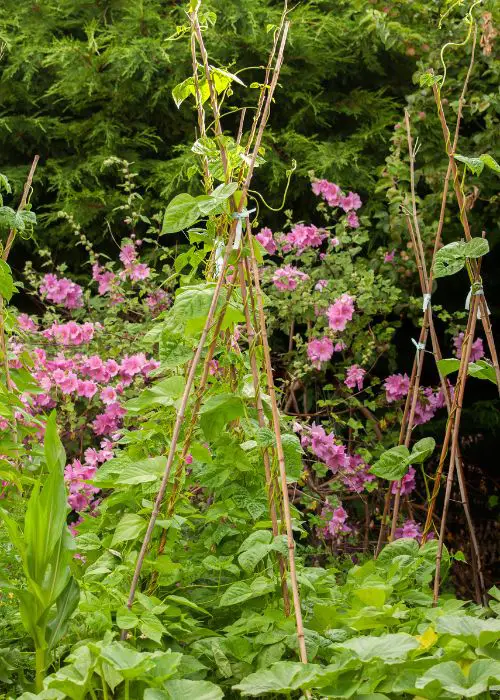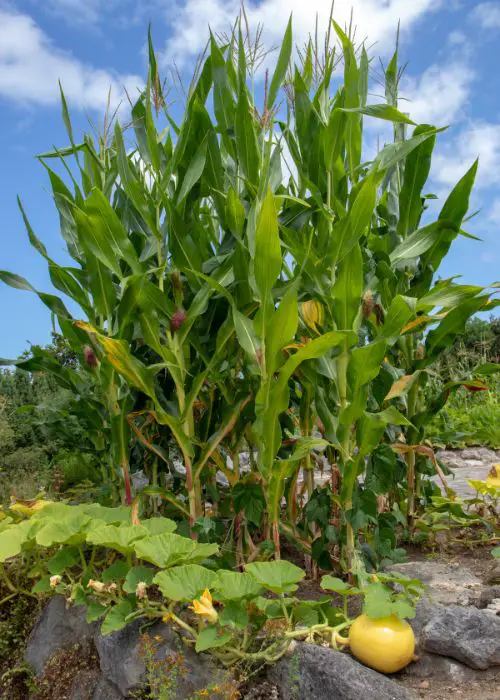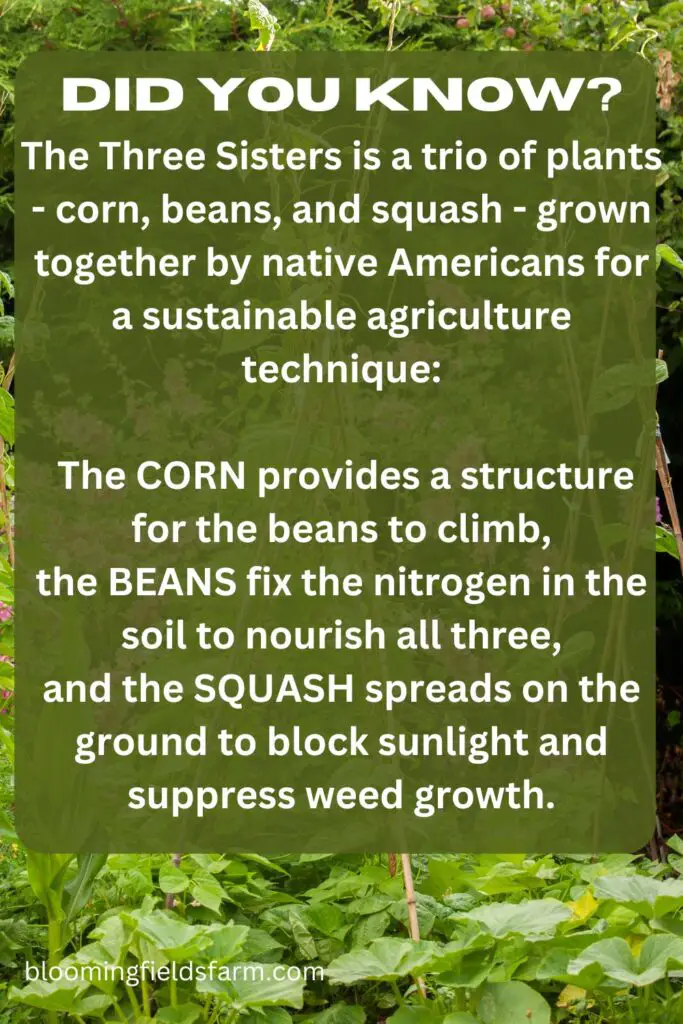Get To Know Three Sisters Agriculture: Sustainable Farming for the Future
Imagine stumbling upon a garden where corn, beans, and squash live in harmony, a trio so inseparable they’d give any famous trio a run for their money.
This isn’t the setup for a quirky botanical sitcom, but a peek into the ingenious agricultural practice known as the Three Sisters.
This method, deeply rooted in Native American farming traditions, isn’t just about growing crops; it’s about growing them together in a way that they benefit each other.
Three Sisters Agriculture Origins and Cultural Significance
I find the story behind the Three Sisters agriculture not just fascinating, but it’s also a powerful testament to indigenous ingenuity.
Rooted deeply in Native American culture, this method isn’t just about planting crops; it’s a coherent system that reflects the communities’ respect for the land and its resources.
Historically, the Three Sisters—corn, beans, and squash—formed a dietary staple that sustained numerous Native American tribes across North America.
They didn’t just stumble upon this trio by chance; it was a deliberate method developed over generations, embodying sustainable farming at its finest.
The cultural significance of the Three Sisters extends beyond nutrition.
In many tribes, these crops symbolize three nurturing spirits that, when brought together, bring forth life.
This spiritual aspect underlines the deep connection between the people and their environment, emphasizing the belief in living in harmony with nature.
The method’s resilience and ability to preserve biodiversity have sparked interest from agricultural scientists and indigenous communities alike, aiming to unravel the secrets behind its success and potentially reintroduce it as a sustainable agricultural practice.

Key Components: Corn, Beans, Squash
Corn, beans, and squash aren’t just randomly chosen crops; they complement each other in ways that enhance growth, improve soil fertility, and fight pests and weeds, showcasing a perfect example of natural synergy.
Corn acts as a natural trellis for beans to climb, eliminating the need for artificial supports.
The beans, in return, fix nitrogen from the air into the soil, providing essential nutrients for all three crops.
Finally, squash spreads across the ground, its broad leaves shading the soil, preserving moisture, and deterring weed growth with its spiky stems.
This trio doesn’t demand much in terms of artificial fertilizers or pesticides, making it an attractive option for sustainable farming.
The efficiency of this system lies in its simplicity and the way it mimics natural ecosystems, creating a balanced and productive crop environment.
Through the Three Sisters, Native Americans demonstrated a profound understanding of agricultural ecology long before modern science began to explore these concepts.
The Science Behind the Method
Nutrient Complementarity and Soil Health
I’ve learned that corn, beans, and squash each play a unique role in creating a balanced, nutrient-rich environment that supports their mutual growth.
Corn acts as a natural trellis for beans, which, in turn, fix nitrogen—a critical nutrient for plant growth—back into the soil, benefiting all three plants.
This relationship is key because many agricultural systems deplete soil nitrogen, but here, beans replenish it without needing artificial fertilizers.
Squash, with its broad leaves, shades the ground, reducing weed growth and helping to maintain soil moisture.
Studies, like those cited by the New York Botanical Garden, underline the way these plants work together to enhance soil structure and health, showcasing how traditional practices intuitively grasped concepts modern agriculture is just beginning to understand.
Benefits of Intercropping
Intercropping, the practice of cultivating two or more crops in proximity, is at the heart of what makes the Three Sisters method so beneficial.
Not only does it optimize space, it dramatically improves plant health and crop yields.
According to Sustainable Agriculture Research and Education (SARE) publications, intercropping offers a multitude of advantages including pest control, disease reduction, and increased biodiversity.
The strategic spacing and variety inherent in the Three Sisters method reduce the likelihood of pests and diseases that can thrive in monoculture settings.
Furthermore, this intercropping system fosters a habitat for beneficial insects and organisms that naturally control pest populations, reducing the need for chemical pesticides.
My dig into research highlighted how the diversity of planted crops leads to healthier soil and, consequently, stronger, more resilient plant communities.
These are vivid examples of how ancient wisdom, when applied through a modern lens, presents solutions to some of contemporary agriculture’s most pressing issues.
In my journey exploring the Three Sisters agriculture method, it’s clear that the principles driving this system—nutrient complementarity, soil health, and the benefits of intercropping—are not just beneficial for the crops themselves but offer a blueprint for sustainable farming practices worldwide.
This deep dive into the science behind the method reaffirms my belief in the potential of integrating traditional agricultural knowledge with modern farming innovations to create more sustainable, efficient, and environmentally friendly food production systems.
Planting and Care

Preparing the Soil
This brilliant method starts with creating a fertile ground for the corn, beans, and squash to flourish together.
Typically, I incorporate a generous amount of compost or well-rotted manure into the planting area.
This not only enriches the soil but also promotes good drainage, which is essential for these plants.
Additionally, because corn is a heavy feeder, ensuring the soil is rich in nitrogen sets the stage for a successful garden.
I also make sure the soil has a neutral pH, testing it beforehand if necessary.
The preparation doesn’t stop there; constructing mounds of soil about a foot high and 20 inches across ensures the roots have ample room to grow and makes it easier for the beans to climb the corn stalks.
Best Varieties for Success
Choosing the right varieties of corn, beans, and squash can make all the difference in the growth and yield of a Three Sisters garden.
From my experience, it’s best to opt for corn varieties that grow tall and strong to support the beans.
Flint or dent corn varieties have served me well, offering the sturdy stalks needed.
When it comes to beans, pole varieties are the go-to since they’ll climb the corn effectively. I’ve had great success with varieties like Rattlesnake or Kentucky Wonder.
For squash, I lean towards varieties that spread out to suppress weeds and shade the soil, like butternut or acorn squash.
It’s all about creating a symbiotic relationship where each plant supports and benefits the others.
Timing and Techniques
Timing is key when planting the Three Sisters.
I start with corn, planting it when the danger of frost has passed and the soil has warmed up sufficiently.
It’s usually about two weeks later when I see the corn has grown enough (about 4 inches tall) that I add the beans and squash to the mix.
This staggered approach ensures the corn is sturdy enough to support the beans.
The technique of planting in mounds comes into play here, with the corn in the center, beans spaced evenly around the corn, and squash seeds around the perimeter of the mound.
This layout maximizes space and promotes beneficial interactions among the plants.
Careful watering, especially as the plants establish, and mulching with straw or leaves to retain soil moisture, are practices that have worked well for me in managing a thriving Three Sisters garden.
Harvest and Storage
After months of tending to my Three Sisters garden, the excitement of harvest season arrives, bringing a bounty of corn, beans, and squash.
Here’s how I handle the harvest and storage of these precious crops, ensuring nothing goes to waste and everything is used to its fullest potential.
Harvesting Practices
I’ve learned to watch for the signs that indicate each sister is ready for harvest.
For corn, it’s when the kernels feel full and are milky when pierced.
Beans should be firm and fully developed, but not dry, while squash is harvested when the skin is hard enough that it can’t be punctured with a fingernail.
Harvesting requires a gentle hand, as these plants have supported each other for months.
I carefully detach beans from the cornstalks they’ve climbed, ensuring the stalks remain intact for as long as possible.
The corn is picked by twisting the ears downward, and squash are cut from their vines, leaving a few inches of stem to prevent rot.
Traditional vs. Modern Storage Methods
In the spirit of the Three Sisters, I blend traditional and modern storage methods to preserve my harvest.
Historically, corn was dried on the cob or shelled and stored in woven baskets, a practice that’s not only sustainable but offers a visually appealing way to store surplus grains.
I’ve adopted this method, hanging corn in a cool, dry place, replicating the natural airflow that Indigenous peoples utilized.
Beans are dried in their pods on the vine, then shelled and stored in jars, mimicking ancient techniques of ensuring seeds remain viable and ready for next season’s planting.
Squash, on the other hand, takes well to modern methods.
After curing in the sun for a week to harden the skin, they’re stored in a cool, dark place.
I’ve found that storing them on shelves allows for air circulation, which prolongs their storage life.
This technique, while newer, honors the spirit of maximizing the harvest’s life span, ensuring that I have a steady supply of squash throughout the winter.
Blending these harvesting and storage methods has not only deepened my appreciation for the wisdom of the Three Sisters method but has also allowed me to enjoy the fruits of my labor long after the growing season has ended.
This approach ensures that my pantry is always stocked with the natural goodness of corn, beans, and squash, keeping me connected to the cycles of nature and the ancient traditions that honor it.
The Future of Three Sisters Agriculture

Sustainability and Environmental Impact
In my years of exploring and writing about agriculture, I’ve learned that this approach significantly minimizes the need for artificial fertilizers and pesticides.
Corn, beans, and squash together create a system that naturally enriches the soil.
Beans, being legumes, fix nitrogen from the air, essentially fertilizing the soil for themselves and their plant companions.
Squash acts as a living mulch, reducing weeds and preserving soil moisture.
Together, they reduce the environmental footprint of farming, a critical factor as we face the challenges of climate change and soil degradation.
Moreover, the diversity encouraged by planting these crops together enhances biodiversity, supporting a wider range of pollinators and beneficial insects.
It’s a stark contrast to the monocultures that dominate much of our modern agricultural landscape, which can be harmful to the soil and local ecosystems.
The resilience provided by this diversity also means that Three Sisters gardens are more capable of withstanding extreme weather, pests, and disease without human intervention.
Potential in Modern Farming
Transitioning toward the future, the principles of the Three Sisters agriculture have enormous potential to be integrated into modern farming operations, both large and small scale.
Urban agriculture projects can particularly benefit from adopting this method.
Given the limited space in urban environments, the vertical growth habit of corn and beans maximizes green spaces efficiently, while squash covers the ground, maximizing the use of available area.
This makes Three Sisters an ideal model for rooftop gardens, community plots, and even indoor farming initiatives using hydroponics or soil-based systems.
On larger scales, implementing Three Sisters can lead to more resilient agricultural systems that are less reliant on chemical inputs, thereby reducing farmers’ costs and exposure to harmful substances.
Moreover, this method can be a step towards revitalizing soil health and fostering long-term sustainability in areas affected by over-farming and soil erosion.
Considering the growing interest in regenerative agriculture, Three Sisters agriculture offers valuable lessons and models that could be adapted to fit a variety of climates and soil types, promoting diversity and sustainability on a broader scale.
In my opinion, the future of agriculture needs to reflect a balance between efficiency and environmental stewardship.
The Three Sisters method embodies this balance, providing a roadmap for how traditional knowledge can inform and enrich modern agricultural practices. It’s a testament to the ingenuity of Native American agricultural practices and a reminder that sometimes, looking back can help us move forward more sustainably.